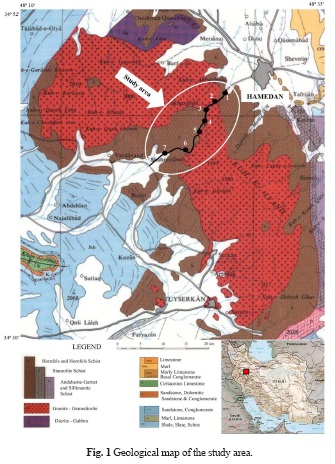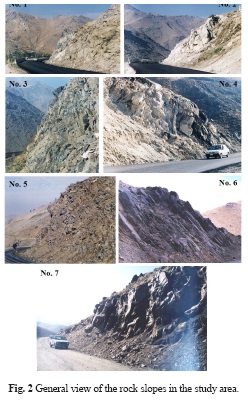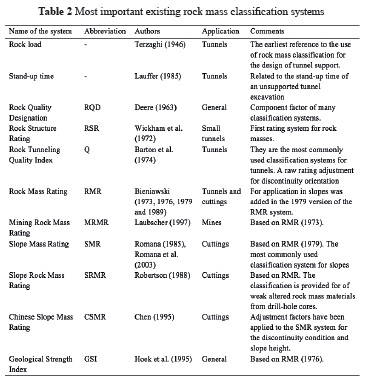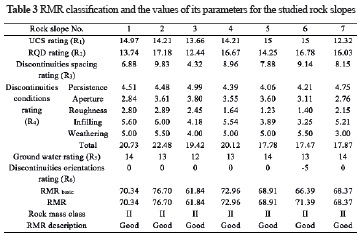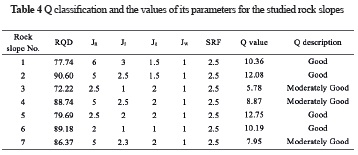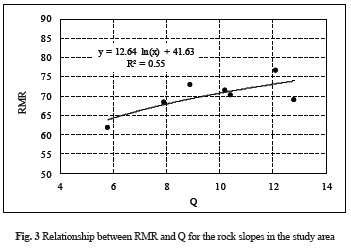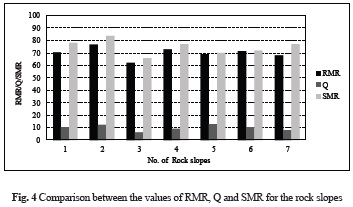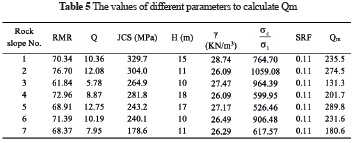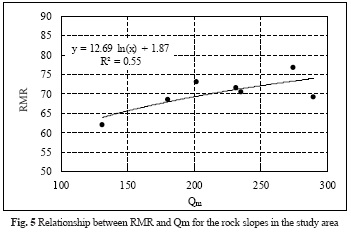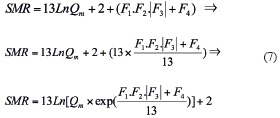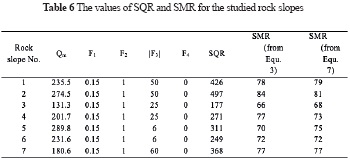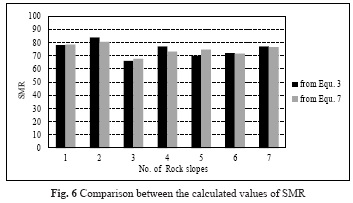Serviços Personalizados
Journal
Artigo
Indicadores
-
 Citado por SciELO
Citado por SciELO -
 Acessos
Acessos
Links relacionados
-
 Citado por Google
Citado por Google -
 Similares em
SciELO
Similares em
SciELO -
 Similares em Google
Similares em Google
Compartilhar
Earth Sciences Research Journal
versão impressa ISSN 1794-6190
Earth Sci. Res. J. vol.19 no.2 Bogotá jul./dez. 2015
https://doi.org/10.15446/esrj.v19n2.49127
http://dx.doi.org/10.15446/esrj.v19n2.49127.
GEOTECHNICS
Assessment of a Modified Rock Mass Classification System for Rock Slope Stability Analysis in the Q-system
Evaluación del Sistema Q Modificado de Clasificación del Macizo Rocoso para el Análisis de Estabilidad de Pendiente de Roca
Davood Fereidooni*1, Gholam Reza Khanlari2, Mojtaba Heidari2
1 School of Earth Sciences, Damghan University, Damghan, Iran d.fereidooni@du.ac.ir (*Corresponding author)
2 Department of Geology, Bu-Ali Sina University, Hamedan, Iran
Record
Manuscript received:12/02/2015 Accepted for publication: 14/06/2015
How to cite item
Fereidooni, D., Reza, G. and Heidari, M. (2015). Assessment of a Modified Rock Mass Classification System for Rock Slope Stability Analysis in the Q-system. Earth Sciences Research Journal, 19(2) 147 - 152. http://dx.doi.org/10.15446/esrj.v19n2.49127.
ABSTRACT
This paper explores the applicability of a modified Q classification system and its component parameters for analysis and conclusion of site investigation data to estimate rock slope stability. Based on the literature, Q classification system has high applicable potential for evaluation of rock mass quality. Therefore, in this study, it was used with RMR and SMR rock mass classification systems to assess stability or instability of different rock slopes along the Hamedan-Ganjnameh-Tuyserkan road, Hamedan province west of Iran. Furthermore, a modified rock mass classification system namely Slope Quality Rating (SQR) was proposed based on the correction of the Q classification parameters and calculating some new parameters such as dip and strike of discontinuities and the method of rock excavation or blasting. For this purpose, the SMR and RMR rock mass classifications were also needed. By measuring SQR for different rock slopes, it will be possible to measure Slope Mass Rating (SMR).
Keywords: Rock mass classification, Rock slope, Q, RMR, SMR, SQR.
RESUMEN
Este artículo explora la aplicabilidad del sistema de clasificación Q modificado y sus parámetros para analizar y determinar la información estimada de estabilidad de pendiente de roca en el sitio determinado de estudio. Según la literatura, el sistema de clasificación Q tiene un alto potencial de aplicabilidad para la evaluación de la calidad del macizo rocoso. En este estudio además se utilizó el sistema Q junto con los sistemas Índice de Masa de Pendiente (SMR) y Clasificación Geomecánica de Bienawski (RMR) para evaluar la estabilidad e inestabilidad de diferentes pendientes rocosas en la carretera Hamedan-Ganjnameh-Tuyserkan, de la provincia de Hamedan, en el Oeste de Irán. Además, se propone el Índice de Calidad de Pendiente (SQR), un sistema de clasificación de macizo rocoso modificado, a partir de la corrección de los parámetros de clasificación Q y el cálculo de nuevos parámetros como pendiente y caída de las discontinuidades y el método de excavación o explosión de la roca. Para esta propuesta también se utilizaron las clasificaciones SMR y RMR. La medición SQR en diferentes pendientes hizo posible el cálculo del sistema SMR.
Palabras clave: Clasificación del macizo rocoso, pendiente rocosa, sistema Q, clasificación de Bienawski, Índice de Masa de Pendiente, Índice de Calidad de Pendiente.
1. Introduction
Rock slope failure along roads, highways, railways and in urban and industrial areas is one of the geologic hazards that will destroy engineering projects such as dams, buildings, roads and railroads. This natural hazard shows the importance of the engineering geology and rock mechanics studies when engineering constructions are performed. In the past decades, the rock mass classification concept has been extensively applied in engineering design of different projects such as tunnels, slopes and foundations. Many researchers have proposed or used rock mass classification systems as an experimental method to assess rock mass quality or rock slope stability (e.g. Bieniawski 1973; Barton 1974; Selby 1980; Haines and Terbrugge 1991; Hack et al. 2003; Liu and Chen 2007; Pantelidis 2010; Hajiazizi and Khatami 2013).
The primary objective of rock mass classification is to provide quantitative data and guidelines for engineering purposes that can improve originally abstract descriptions of geological formation (Liu and Chen 2007). Over the last several years, different rock mass classification systems have been proposed for rock cuttings with high risk to identify their failure potential to present preventive and improvement methods. Also, rock mass classification is mean for the evaluation of the performance of rock cut slopes based on the most important inherent and structural parameters (Pantelidis 2009). In other words, rock mass classification systems try to consider the most important aspects affecting the rock mass, to rate its quality (Tzamos and Sofianos 2007). Based on Bieniawaski (1989), the main aim of rock mass classification systems is dividing particular rock masses into groups of similar behavior and also providing a basis for understanding the characteristics of each cluster to yield quantitative data for engineering purposes, and at least providing a common basis for communications between the researchers.
Most of the multi-parameter classification schemes are developed from civil engineering case histories in which all of the components of the engineering geological character of the rock mass are included. Different classification systems place different emphases on the various parameters (Hoek 2007). These statements show that the study of rock mass classifications must be done before performing engineering constructions.
Some of rock mass classifications proposed by different researchers need to be modified to improve their applications. For example, Romana (1985) changed the RMR rock mass classification system based on four different parameters for rock slope stability analysis. In this research, the rock masses in the margin of Hamedan-Ganjnameh-Tuyserkan road in Hamedan province, west of Iran, have been studied based on RMR, SMR, and Q rock mass classification systems. The Q classification system was modified using the parameters proposed by Romana (1985) and also some other parameters. Also, based on the data analysis from the seven rock slopes chose in the study area, a new rock mass classification system (Slope Quality Rating, SQR) is applied and proposed.
2. Geological setting
The study area, longitude from 48° 10' E to 48° 35' E and latitude from 34° 30' N to 34° 52' N, is located on the Sanandaj-Sirjan structural zone, west, and south west of Iran. One of the most important and interesting plutonic rocks of Iran named Alvand batholith is situated in this area. Alvand granitic rock mass is limited from the north to Hamedan, from southeast to Tuyserkan and from northwest to Assad-Abad. It covers an area of about 400 km2 which makes it the largest plutonic rock mass in Iran. According to Sepahi Gero (1999), the major part of Alvand plutonic rock mass consists of porphyritic granites (monzo granite-granodiorites), mezocrate granites and holocrate granites. The metamorphic rocks occurred around Alvand granitic rock masses are pelitic hornfels and schist. Various discontinuities such as tectonic joints, schistosity and cleavage planes were developed in these rocks and can cause rock slope instability, especially on the margin of the Ganjnameh-Shahrestaneh road. The geology deposits close to the north and east side of the study area are the quaternary alluvial fans. Fig. 1 shows the location of the studied rock slopes on the geological map of the region. Fig. 2 shows a general view of the two of the seven studied rock slopes in the study area. Physical and lithological properties of the seven studied rock slopes have been listed in Table 1.properties of the seven studied rock slopes have been listed in Table 1.
3. Most important existing rock mass classifications
Rock mass classifications are a universal communication system for their users. Some of rock mass classifications such as Q, RMR and MRMR systems have been applied successfully in tunneling and underground excavations. Some of these systems have been used for slopes (e.g. Q and RMR system) or have been modified for slopes (e.g. the RMS, SMR, SRMR and CSMR systems comprise modifications of the RMR system). Although, the classification schemes are appropriate for their original application (tunneling), especially when used within the bounds of the case histories from which they were developed, considerable caution must be exercised in applying rock mass classifications to other rock engineering problems (Pantelidis 2009). A detailed list of the most important empirical rock mass classification methods developed world-wide is presented in Table 2.
The RMR and Q classification systems, two of the most important systems, were proposed by Bieniawski (1973) and Barton et al. (1974), respectively. Bieniawski (1989) developed his rock mass classification scheme (RMR) using data obtained mainly from civil engineering excavations in sedimentary rocks in South Africa. The classification system based on rock mass quality (Q) was originally developed by Barton et al. (1974) to assist in the empirical design of tunnel and cavern reinforcement and support, but it has been used for several other tasks in rock engineering in recent years by Barton et al. (2002). Common parameters in these classifications are those concerning rock structure and joint surface conditions. The RMR-value is obtained from the following equation (Bieniawski 1989):
where, R1 is uniaxial compressive strength of rock material , R2 is Rock Quality Designation (RQD), R3 is spacing of discontinuities, R4 is condition of discontinuities, R5 is groundwater conditions and R6 is orientation of discontinuities. The Q-value is estimated from the following expression (Barton et al. 2002):
where, RQD is the percent of competent drill-core sticks >100 mm in length in a selected domain, Jn is the rating for the number of joint sets (9 for 3 sets, 4 for 2 sets, etc.) in the same domain, Jr is the rating for the roughness of the least favorable of these joint sets or filled discontinuities, Ja is the rating for the degree of alteration or clay filling of the least favorable joint set discontinuity, Jw is the rating for the water inflow and pressure effects, which may cause outwash of discontinuity infillings, and SRF is the rating for faulting, for strength/stress ratios in hard massive rocks, for squeezing or for swelling.
With attention to the equations of the Q and RMR systems, it is noticed that the RMR value is obtained from summation of five parameters whereas the Q value is obtained by products and divisions of the six parameters. So, the number of the parameters participated in the Q system is more than that in the RMR system. The RMR parameters are uniaxial compressive strength (σc), rock quality designation (RQD), spacing of the joint sets, discontinuities conditions, and ground water condition. In the Q system, in addition to the above parameters, some new parameters such as Jn(factor of joint sets number), Jr(factor related to the joint roughness), Ja (factor related to the joint alteration), and SRF (Stress Reduction Factor) are also employed.
In the Q equation, the ratio of (RQD/Jn) clearly indicates the effect of block size on the instability of the rock masses. Other ratios are (Jr/Ja)and (Jw/SRF) related to the shear strength and stress conditions, respectively, and they have very important roles in the behavior of the rock masses.
One of the most important problems in the stability of rock slopes is shear strength of discontinuities and joint surfaces which are affected by the block size and the roughness of discontinuities. In addition, the weathering of discontinuity surfaces will have a negative effect on the shear strength of rock masses. Another factor which has a negative effect on the shear strength of rock masses is the presence of the water on the discontinuities which will increase the pore pressure and decrease the shear strength. These conditions will lead to the instability of rock masses and all of them are contributed in the Q classification. Therefore, the presented contributed parameters in the Q equation show that this classification system has a high potential in comparison with the RMR system to evaluate the rock mass quality. As a result, it is possible to say that the Q system can present a good quantitative description of rock mass quality.
4. Relationship between RMR and Q
The application details of the RMR and Q classifications for the seven studied rock slopes are shown in Tables 3 and 4. In an overall view, the results of the classifications show that the rock slopes in the study area are placed in the good rock class. To make a correlation between RMR and Q, the values of these parameters related to the seven studied rock slopes have been plotted in Fig. 3.
According to the Fig. 3, it can be concluded that the relationship between the two mentioned parameters can be estimated as follow:
The equations similar to Equation 3 have been proposed by some researchers such as Bieniawski (1989) which is as follow:
Singh and Goel (2000) mentioned that due to the low correlation coefficient of such equations, they have low validity.
5. Modification of Q classification
The rock Mass Rating system (RMR) was modified by Romana (1985) for rock slope stability analysis purposes. Romana (1985) proposed some new factors such as discontinuity orientations, pattern of discontinuities and the methods of blasting for modification of the RMR system. These factors depend on the existing geometrical relationship between discontinuities affecting the rock mass and the slope excavation method. He proposed Slope Mass Rating (SMR) which can be measured from the following equation:
where, SMR is Slope Mass Rating, RMRbasic is basic Rock Mass Rating, F1 is difference between slope face and critical discontinuity strike, F2 is discontinuity dip angle, F3 is difference between the slope face angle and the dip of critical discontinuity and F4 is method of excavation. Among all available rock mass classifications, SMR is the most extended one and is applied for rock slopes due to its ease and exhaustive, well established, quantitative definition of correction factors. Fig. 4 shows a comparison between the values of RMR, Q and SMR for the seven rock slopes. The values of these parameters have a good coordination.
In this research, presented parameters in Equation 5 were used to modify of the Q system. Because of some difficulties derived from using the Q system, now it is used for rock slope stability and open pit mining in some cases. Due to the stress condition at the surface and depths, distinguishing between these two conditions is necessary. For this reason, it seems that there is necessary to make some changes to the value of SRF parameter. Ajoodani-Namin (1999) proposed that we can use (JCS /  H ) factor of SRF in order to incorporate the effect of stress differences in different conditions (depth and surface of the rock masses). Based on a try and error method, Ajoodani-Namin (1999) suggested following conditions:
H ) factor of SRF in order to incorporate the effect of stress differences in different conditions (depth and surface of the rock masses). Based on a try and error method, Ajoodani-Namin (1999) suggested following conditions:
If; (JCS /
H) < 160 →SRF = 0.35
If; (JCS /
H) ≥ 160 →SRF = 0.11
where, JCS is Joint Compressive Strength (MPa),  is unit weight of rock slope materials (g/cm3) and H, is the height of rock slope (m). Based on this condition, the value of SRF for the study area was chosen 0.11 and, therefore, the value of Q was corrected for the slope stability applications. Details of modified Q (Qm), RMR, JCS, SRF and other parameters are listed in Table 5.
is unit weight of rock slope materials (g/cm3) and H, is the height of rock slope (m). Based on this condition, the value of SRF for the study area was chosen 0.11 and, therefore, the value of Q was corrected for the slope stability applications. Details of modified Q (Qm), RMR, JCS, SRF and other parameters are listed in Table 5.
In order to make a correlation between RMR and Qm, the values of these parameters are plotted in X-Y system (Fig. 5). According to Fig. 5, the relationship between the two mentioned parameters is as follow:
6. Calculation of SQR
With combining Equations 5 and 6, it is possible to achieve the value of SQR based on the following processes:
As it is clear from Equation 7, the value within bracket is rating of SQR for the rock masses of the study area which can be calculated from the below equation:
As a result, the relationship between SMR and SQR will be as follow:
Based on the table proposed by Romana (1985), the values of F1, F2, F3 and F4 for the studied rock slopes are listed in Table 6.
Fig. 6 shows a comparison between calculated values of SMR from Equations 5 and 9 for the seven rock slopes. The values of these parameters have a good coordination.
7. Conclusions
The modified Q classification system (SQR) is one of the rock mass classifications that can be applied for rock slope stability analysis. This classification has been concluded from three rock mass classifications means RMR, Q, and SMR. Application of SQR classification system for the rock slopes in the study area has presented good results and shows that this classification is a very useful method to analyze the rock slope stability. Furthermore, with the application of this method, we can calculate SMR values.
The estimated values of RMR in the seven studied rock slopes show that the minimum value of RMR (62) is related to the rock slopes No. 3 and the maximum value of RMR (77) is linked to the rock slopes No. 2. By the results, the studied rock slopes are placed in the good rock class (class II). The measured SMR for the seven studied rock slopes shows that the minimum value of SMR (66) is related to the rock slopes No. 3 and the maximum value of SMR (84) is linked to the rock slopes No. 2. The results show that the studied rock slopes have good quality and stable condition (class II). The Calculated values of Q for the seven studied rock slopes show that the minimum value (5.8) is related to the rock slopes No. 3 and the maximum value (12.8) is linked to the rock slopes No. 5. The results show that the rock qualities of the rock slopes are fair and good, respectively. The measured SQR for the seven rock slopes shows that the minimum value of SQR (177) is related to the rock slopes No. 3 and the maximum value of SQR (497) is linked to the rock slopes No. 2. The results show that the studied rock slopes have good quality. The values of SMR from the equation proposed in this research (Equation 9) have proper coordination with the values of SMR from the equation suggested by Romana (1985) (Equation 5). In other words, the values of SMR, from two mentioned methods, for the rock slope No. 3 and the rock slope No. 2 are minimum and maximum, respectively (Fig. 6). In this study, similar results were obtained from RMR, SMR, Q and SQR rock mass classification systems for all seven studied rock slopes. This means that these classifications are in coordination with each other in assessing rock slope stability analysis in the study area.
References
Ajoodani-Namin S. (1999). Proposed a new method for rock slope stability analysis with modification of Q system, MSc thesis, Tarbiat Modarres University, Tehran, Iran, (in Persian). [ Links ]
Barton N. R., Lien, R. and Lunde J. (1974). Engineering classification of rock masses for the design of tunnel support, Rock Mechanics and Rock Engineering. 6, no. 4, 189-239. [ Links ]
Barton, N. (2002). Some new Q-value correlations to assist in site characterization and tunnel design, International Journal of Rock Mechanics and Mining Sciences. 39, 185-216. [ Links ]
Bieniawski, Z. T. (1973). Engineering classification of rock masses, Trans South African Institute of Civil Engineering. 15, 335-44. [ Links ]
Bieniawski, Z. T. (1976). Rock mass classification in rock engineering, Proceedings of the symposium on explorer for rock engineering, Johannesburg, 97-106. [ Links ]
Bieniawski, Z. T. (1979). The geomechanics classification in rock engineering applications, Proceedings of the 4th international congress on rock mechanics, Montreux, 41-48. [ Links ]
Bieniawski, Z. T. (1989). Engineering rock mass classifications, New York: Wiley [ Links ]
Chen, Z. (1995). Recent developments in slope stability analysis, Proceedings of the 8th international congress ISRM, Tokyo, 1041-8. [ Links ]
Deere, D. U. (1963). Technical description of rock cores for engineering purposes, Rock Mech. Eng. Geol. 1, no. 1, 17-22. [ Links ]
Haines, A. and Terbrugge, P. J. (1991). Preliminary estimation of rock slope stability using rock mass classification systems, In: Wittke, W. (Ed.), Proc 7th Congr on Rock Mechanics 2, ISRM, Aachen, Germany. Balkema, Rotterdam, 887-892. [ Links ]
Hajiazizi, M. and Khatami R. S. (2013). Seismic analysis of the rock mass classification in the Q-system, International Journal of Rock Mechanics and Mining Sciences. 62, 123-130. [ Links ]
Hack, R., Price, D. and Rengers N. (2003). A new approach to rock slope stability-a probability classification (SSPC), Bulletin of Engineering Geology and the Environment. 62(2), 167-184. [ Links ]
Hoek, E., Kaiser P.K. and Bawden, W. F. (1995). Support of underground excavations in hard rock. Rotterdam: Balkema. [ Links ]
Hoek, E. (2007). Practical Rock Engineering, http://rockeng.utoronto.ca/rok/Hoek/Hoeknote2007.htm. 2008-11-04. [ Links ]
Laubscher, D. H. (1997). Geomechanics classification of jointed rock masses-mining applications, Trans Inst. Min. Metall. 86, 1-8. [ Links ]
Lauffer, H. (1985). Gebirgs klassifizierung fur den Stollenbau, Geol Bauwesen. 24, no. 1, 46-51. [ Links ]
Liu, Y. C,. and Chen, C. S. (2007). A new approach for application of rock mass classification on rock slope stability assessment, Engineering Geology. 89, 129-143. [ Links ]
Pantelidis, L. (2009). Rock slope stability assessment through rock mass classification systems, International Journal of Rock Mechanics & Mining Sciences. 46, no. 2, 315-325. [ Links ]
Pantelidis, L. (2010). An alternative rock mass classification system for rock slopes, Bulletin of Engineering Geology and the Environment. 69, 29-39. [ Links ]
Robertson, A. M. (1988). Estimating weak rock strength, Proceedings of the SME annual meeting, Phoenix, 1-5. [ Links ]
Romana, M. Seron, J. B. and Montalar, E. (2003). SMR Geomechanics classification: application, experience and validation, Proceedings of the international symposium on role of rock mechanics, South African Institute of Mining and Metallurgy, 1-4. [ Links ]
Romana, M. (1985). New adjustment ratings for application of Bieniawski classification to slopes, Proceedings of Int. Symp. Role of Rock Mech., ISRM, Zacatecas, Mexico, 49-53. [ Links ]
Selby, M. J. (1980). A rock mass strength classification for geomorphic purposes: with tests from Antarctica and New Zealand, Zeitschrift fur Geomorphologie, 23, 31-51. [ Links ]
Sepahi-Gero, A. A. (1999). Petrology of Alvand Plutonic with emphasis on granitoieds, PhD thesis on petrology, Kharazmi University, Tehran, Iran, (in Persian). [ Links ]
Singh, B. and Goel, R. K. (2000). Rock mass classification (A practical approach for civil engineering), Elsevier Ltd. [ Links ]
Terzaghi, K. (1946). Rock defects and loads on tunnel supports, Rock tunneling with steel supports. vol. 1, Youngstown, OH: Commercial Shearing and Stamping Company, 17-99. [ Links ]
Tzamos, S. and Sofianos, A. I. (2007). A correlation of four rock mass classification systems through their fabric indices, International Journal of Rock Mechanics & Mining Sciences. 44, 477-495. [ Links ]
Wickham, G. E., Tiedemann, H. and Skinner, E. H. (1972). Support determination based on geologic predictions, Proceedings of the 1st North American rapid excavation tunneling conference, New York: AIME, 43-64. [ Links ]













